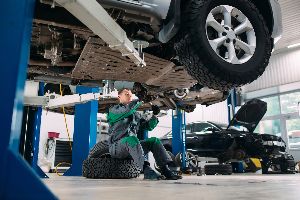
Without functional car brakes, an otherwise-perfect vehicle becomes unsafe. Learning about the main parts making up a brake system helps you identify maintenance issues and schedule timely auto repair services. The guide below offers a summary of these components.
What Elements Make Up Your Car's Braking System?
1. Pads
Made from ceramic, non-asbestos organic, or semi-metallic materials, the pads activate when you hit the brake pedal, causing the master cylinder to deliver fluid into the calipers on each wheel. The fluid forces the calipers to squeeze the pads onto the rotor to slow the vehicle down.
Brake pads eventually wear out and make squealing or screeching noises upon rotor contact. This means they need to be replaced—usually every 40,000 to 50,000 miles. By paying attention to braking system noises, you’ll prevent worn pads from warping the rotor, which is a much more expensive problem to fix.

2. Rotor
A round disc, the rotor makes contact with the brake pads to complete the stopping process. The rotor slows the axle, the part of the car the wheels connect to, causing them to stop. If the rotor warps from worn brake pad friction, you’ll have issues decelerating and will likely hear grinding sounds when you hit the brake pedal. The pedal can also start vibrating because of increased friction. Replace brake pads when they hit their service limit of 0.1 inches to avoid warped rotor issues.
3. Caliper
There’s a caliper on each wheel of your vehicle. These squeeze the pads against the rotor, slowing the axle and, subsequently, the wheels. Car brake inspections check for bent calipers or loose nuts and bad bearings that can cause the parts to lock up. If a caliper locks up, the wheel does too and pulls the vehicle in the same direction.
4. Master Cylinder
The master cylinder is usually located on the vehicle firewall, the wall between the engine and the cab. It houses brake fluid and delivers the liquid to the calipers as necessary to stop the vehicle. Check brake fluid about every 5,000 miles to avoid low fluid levels and braking problems. A spongy brake pedal can indicate a fluid leak. Flush the system and replace this fluid every two to three years.
Keep your car brakes functional and safe with services from Dirk’s Auto Repair. The auto repair shop has served drivers throughout Lincoln, NE, since 1995, providing oil changes, tire rotations, and auto diagnostics, among other services. Call (402) 466-6010 to make an appointment or visit the website for auto service details. Get more auto maintenance tips on Twitter.
About the Business
Have a question? Ask the experts!
Send your question

